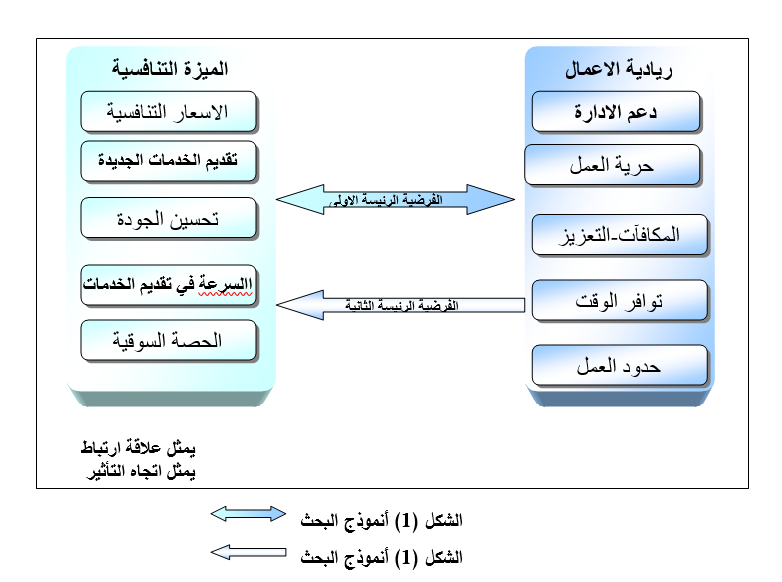The role of entrepreneurship in achieving competitive advantage - an exploratory study of the opinions of a sample of managers in private Iraqi banks
Keywords:
entrepreneurship and competitive advantageAbstract
The purpose of this search is know the Role of entrepreneurial business in competitive advantage of for Iraqi private banks, through relationship and effect, The present search is applied on (70) subjects selected randomly from (10) Iraqi private banks. Questionnaire , interviews, and the researcher\'s personal observations are all regarded as strategies for data collection. Many statistical procedures are used ,like variance, Multiple Regression. The main findings is :There are asignifinct relationship and effect of the entrepreneurial business dimensions in competitive advantages, The importance recommendations of this study was all relevant to the processes adopted by Iraqi private banks in implementing creative entrepreneurial business dimensions , in creating positive changes in the competitive strategy of time , speed, achievement of customers\' services, and its relevance in increasing more market share.
References
المصادر الانجليزية
Appelbaum, E. (2002), Thr impact of new forms of work organization on workers, in Murray, G., Brlanger, J., Giles, A. and Lapointe, P. (Eds), Work and Employment Relations in the High-performance Workplace, Continuurn, London, pp 120-49.
Barringer, M.W. and Milkovich, G.T. (1998), A theoretical exploration of the adoption and design of flexible benefits plans: a case of human resource innovation, Academy of Management Review, Vol. 23 No. 2, pp. 305-24.
Barney, Jay., (1991), "Firm Resources Sustain Competitive Advantage, Journal of Mnagement, Vol 17,No 1,pp.99-120.
Bird, B. (1988), “Implementing entrepreneurial ideas: the case for intention”, Academy of Management Review, Vol. 13 No. 3, pp. 442-53.
Chen, Jin . Zhu, Wang Z. A, , (2005), A system model for corporate entrepreneurship, International Journal of Manpower Vol. 26 No. 6, pp. 529-543
Covin, J.G. and Slevin, D.P. (1991), ‘‘A conceptual model of entrepreneurship as firm behavior’’, Entrepreneurship Theory and Practice, Vol. 16 No. 1, pp. 7-26.
Czepil, J., (1992), "Competitive Marketing Strategy" Prentice-Hall, New Jersey.
David, Fred R. (2007).Strategic Management Concepts, (11th Ed). New Jersey: Pearson Prentice Hall.
Drucker, P.F. (1985), Innovation and Entrepreneurship, 2th ed, London.
Dubini, P. and Aldrich, H (1991) ‘Personal and extended networks are central to the entrepreneurial process’ Journal of Business venturing 6, 305-313
Feldman, M.P. (2005), “The entrepreneurial event revisited: firm formation in a regional context”, in Breschi, S. and Malerba, F. (Eds), Clusters, Networks, and Innovation, Oxford University Press, Oxford, pp. 136-68.
Helfat, C.E., Harris, D. and Wolfson, P.J. (2006), ‘‘The pipeline to the top: women and men in the top executive ranks of U.S. corporations’’, Academy of Management Perspectives, Vol. 20 No. 4, pp. 42-64.
Hitt, M.A., Ireland, R.D., Camp, S.M. and Sexton, D.L. (2001), “Strategic entrepreneurship:entrepreneurial strategies for wealth creation”, Strategic Management Journal, Vol. 22No. 479, p. 491 (special issue).
Ifinedo, Princely, (2008), Impacts of business vision, top management support, and external expertise onERPsuccess, Business Process Management Journal Vol. 14 No. 4, pp. 551-568
Ireland, R.D., Hitt, M.A., Camp, S.M. and Sexton, D.L. (2001), “Integrating entrepreneurship and strategic management actions to create firm wealth”, Academy of Management Executive, Vol. 15 No. 1, pp. 49-63.
Ireland, R., Hitt, M. and Sirmon, G. (2003), “A model of strategic entrepreneurship: the construct and its dimensions”, Journal of Management, Vol. 29 No. 6, pp. 963-89.
Kyrgidou Lida P., Hughes, Mathew, (2010) A: Strategic entrepreneurship: origins, core elements and research directions, European Business Review Vol. 22 No. 1, pp. 43-63.
Lancaster, Geoff and Lastor, Goham M., (2000), Marketing management, The McGrav-Hitt Companines,Inc.London
Luke Belinda and Verreynne Martie-Louise.,( 2006),Exploring strategic entrepreneurship in the public sector, Qualitative Research in Accounting & Management Vol. 3 No. 1, pp. 4-26
Lumpkin, G.T. and Dess, G.G. (1996), “Clarifying the entrepreneurial orientation construct and linking it to performance”, Academy of Management Review, Vol. 21 No. 1, pp. 135-72.
Lynch, Richard, (2000), "Corporate Strategy" 2th Ed, Prentice-Hall, Inc., U.S.A.
Morris, M.H., Kuratko, D.F. and Covin, J.G. (2008), Corporate Entrepreneurship and innovation, South- Western College, Mason, OH.
Porter M, (1987), ” From competitive advantage to corporate strategy”, Harvard Business Review, Vol 3, No. 6, P. 46.
Rothwell, W.J. and Lindholm, J.E. (1999), “Competency identification, modelling assessment inthe USA”, International Journal of Training Development, Vol. 3, pp. 90-105.
Studdard, L. Nareatha & Munchus, George, (2009), Entrepreneurial firms’ acquisition of knowledge using proactive help-seeking behaviour , International Journal of Entrepreneurial Behaviour & Research Vol. 15 No. 3, pp. 242-261
Sykes, H.B. and Block, Z. (1998), Corporate venturing obstacles: sources and solutions, Journal of Business Venturing, Vol. 4 No. 3, pp. 159-67.
Teece, J. David,(2000) “Strategies for Managing Knowledge Asset: the Rolr of Firm Structure and Industrial Context” Inc., U.S.A
Westhead, P., (2003), “Company performance and objectives reported by first and multi-generation family companies: a research note”, Journal of Small Business and Enterprise Development, Vol. 10 No. 1, pp. 93-105.
Zahra, S.A. (1999), “The challenging rules of global competitiveness in the 21st century”, Academy of Management Executive, Vol. 13 No. 1, pp. 36-42.
Zahra, S.S., Neuvaum, D.O. and Huse, M. (2000), “Entrepreneurship in medium-size companies: exploring the effects of ownership and governance systems”, Journal of Management, Vol. 26 No. 5, pp. 947-76.

Downloads
Published
How to Cite
Issue
Section
License
Copyright (c) 2013 Iraqi Journal for Administrative Sciences

This work is licensed under a Creative Commons Attribution-NonCommercial-NoDerivatives 4.0 International License.
Authors retain the copyright of their papers without restrictions.









